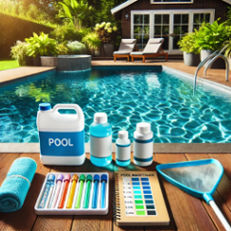Maintaining the right balance in your pool water is key to ensuring it stays clean, safe, and enjoyable for everyone. Properly balanced water isn’t just about appearance; it also prevents bacteria, prolongs your pool equipment’s life, and provides a comfortable swimming experience.
Ga-Pools offers professional pool maintenance services tailored to keep your pool in top condition year-round. Their expert team ensures clean, balanced water for a safe and enjoyable swimming experience.
Why Pool Water Balance Matters
Balanced pool water protects both the swimmers and the pool itself. When your water is balanced:
- Swimmers experience fewer irritations in eyes and skin.
- Your pool equipment lasts longer.
- Water remains clear and free from harmful bacteria.
Keeping the water chemistry in check ensures a healthy swimming environment and reduces the frequency of costly repairs.
Key Elements of Pool Water Balance
To keep your pool water balanced, it’s essential to maintain the following levels:
1. pH Level
The pH level measures how acidic or alkaline the water is. Ideal pH levels should range from 7.4 to 7.6. Low pH can lead to corrosion of metal components, while high pH can cause scaling and cloudy water.
- Lowering pH: Use pH reducers or muriatic acid.
- Increasing pH: Add soda ash or baking soda.
2. Alkalinity
Total alkalinity helps buffer the pH level, preventing sudden changes. The recommended range is 80 to 120 ppm. Proper alkalinity keeps the water stable, reducing the need for constant pH adjustments.
- Raising Alkalinity: Use sodium bicarbonate.
- Lowering Alkalinity: Muriatic acid can help adjust the levels.
3. Calcium Hardness
Calcium hardness is essential for preventing corrosion and scaling. The ideal range for calcium hardness is 200 to 400 ppm. High calcium levels cause scaling, while low levels can corrode pool surfaces.
- Increasing Hardness: Add calcium chloride to raise calcium levels.
- Decreasing Hardness: Partially drain and refill the pool with fresh water.
4. Chlorine Levels
Chlorine is a disinfectant that keeps your pool water free from bacteria and algae. The optimal chlorine level should be 1 to 3 ppm. Ensure that you’re regularly testing and adjusting chlorine to prevent the buildup of harmful microorganisms.
5. Cyanuric Acid
Cyanuric acid, or stabilizer, protects chlorine from being destroyed by sunlight. For outdoor pools, a stabilizer level of 30 to 50 ppm is ideal. Proper stabilizer levels mean your chlorine works effectively, even on sunny days.
Steps to Maintain Pool Water Balance
Balancing pool water requires regular testing and adjusting of the chemical levels. Follow these steps to ensure your pool stays in top condition:
1. Test Water Regularly
Test your pool’s chemical levels at least once a week, more frequently in peak season. Use test strips or a digital testing kit to measure pH, alkalinity, chlorine, and other essential levels.
2. Adjust Chemicals as Needed
Based on your test results, add the necessary chemicals to bring your water into balance. Always follow product instructions, and add chemicals gradually to avoid overcorrection.
3. Use a Pool Shock Treatment
Shock your pool every few weeks or after heavy usage. Pool shock treatments eliminate contaminants, keeping your water clear and odor-free.
4. Monitor Water Temperature
Water temperature affects chemical reactions. Warmer water can increase the consumption of chlorine and lead to faster evaporation. Regularly adjust your chemicals based on the water temperature.
5. Clean Filters and Skimmers
Ensure that your pool’s filters and skimmers are clean and functioning well. Regularly cleaning these components prevents debris buildup and maintains effective water circulation.
Common Pool Water Balance Issues and Solutions
Even with regular maintenance, pool water can sometimes go out of balance. Here are common issues and quick solutions:
- Cloudy Water: Caused by high pH or calcium levels. Adjust pH or perform a shock treatment.
- Eye and Skin Irritation: Usually due to low pH or high chlorine levels. Balance the pH or reduce chlorine.
- Algae Growth: Low chlorine or cyanuric acid can allow algae to thrive. Shock the pool and adjust the chlorine levels.
Conclusion: Enjoy a Refreshing Pool All Season Long
Achieving the perfect pool water balance may seem complex, but with consistent testing and adjustments, you’ll create an ideal swimming environment for friends and family. With a few routine practices, your pool will remain clean, safe, and ready for a refreshing dip at any time.

